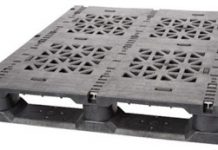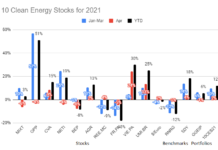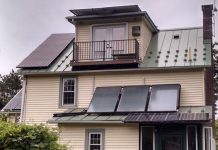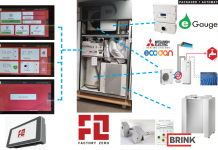Two months ago, I was talking to an experienced entrepreneur who was exploring business models to provide geothermal heat pumps to households. At first blush, it seems like a great idea. Geothermal heat pumps often have payback periods of under five years, which translates into internal rates or return in excess of 20% over the 30 year life of the system. With plenty of room for a business to recoup its cost of capital and leave some money on the table for the consumer, it’s amazing that there isn’t a company in every jurisdiction already active in the market.
In fact, sellers of geothermal heat pumps are few and far between. Google searches for "buy geothermal heat pump" and "buy geoexchange" (an alternate name) drew less than 300,000 hits combined, while searches for "buy furnace" and "buy air conditioner" drew over 2,500,000 hits each. Why is that?
Barriers to Energy Efficiency
When I spoke to the same prospective geothermal heat pump entrepreneur again a month later, he told me he couldn’t figure out how to make money on the deal. Nor can I. The economics work best with new construction, but builders have no incentive to save their customers money on their utility bills. In a case study from Delta-Montrose Rural Electric Association (DMEA), a progressive Colorado electric cooperative, they identified purchase cost as the main barrier to adoption. DMEA was able to overcome that by financing the systems for their members (customers) with a payment on their monthly utility bill, something they are in a unique position to do, because they are also the electric utility.
Most utilities will not support energy efficiency programs without regulatory intervention. Since energy efficiency programs reduce the total electricity sold, and electric rates are set by regulators, without decoupling, energy efficiency measures reduce the utilities profits. A utility helping its customers reduce their usage would be like General Motors encouraging people to carpool so they could buy fewer cars.
Utility rate decoupling can fix this disincentive for a utility to work with consumers to reduce their usage, but a mental shift is also necessary for utilities to take on the challenge of working with customers to help them reduce their rates. After all, DMEA is one of a very few rural electric cooperatives with an aggressive energy efficiency program. Despite the fact that the co-ops are owned by their members, and so, unlike investor owned utilities, they should be more interested in their customers’ welfare, some investor owned utilities (usually spurred on by regulators Coops, because of their mutual structure, are mostly unregulated), as wells as municipally owned utilities which are much more likely to embrace energy efficiency programs.
Eric Hirst of Oak Ridge National Laboratory identifies these barriers to energy efficiency improvements:
| Barriers to improving U.S. energy efficiency | |
|---|---|
Structural barriersconditions beyond the control of the end user
|
Behavioral barriersconditions that characterize end users
|
For investor owned utilities (IOUs), the problems are mostly those of misplaced incentives, and attitudes. When the state regulator changes the incentives, a well run IOU will quickly change its attitude. IOUs are in business to make money, and so they respond to incentives. For a rural cooperative, I believe the main barriers are attitudes, awareness, limited ability to obtain an process information, and possibly perceived riskiness. Since co-ops are responsible only to their members, and their customers are typically even less educated about the potential for improved efficiency to increase their well being than the utility that serves them, there is no reason for the coop to change its way of doing business. Co-op boards’ main incentive is to keep their members happy. Often the simplest way to do that is my keeping them ignorant.
Barriers for Business
The landscape for a traditional business to make money for energy efficiency is different. The main barriers confronting a business such as an entrepreneur wanting to sell geothermal heat pumps, will be problems of misplaced incentives and the attitudes, awareness, perceptions, and general level of knowledge of their potential consumers.
Continuing with the heat pump example, if an entrepreneur tries to sell the ground source heat pumps to homebuilders, who would be able to install it most cheaply and thus achieve the highest rates of return, he is confronted by misplaced incentives. The builder will not be pay the future utility costs of the house he is building, and so does not have any incentive to pay extra for a system from which he will not receive the benefit. If the entrepreneur attempts to sell the heat pump to the homeowner, he is confronted with the difficulties of drilling holes for the geoexchange loops next to an existing home, which will greatly increase the price of the system and lower the effective rate of return. If, despite this, the system still has an attractive rate of return, he will still be confronted by the homeowner’s limited access to capital or, if he finances the purchase for the customer, there will be the inconvenience and added cost of billing the customer on a regular basis (an inconvenience that DMEA was able to avoid by including the costs in their electric bill.)
There are Opportunities
This is not to say that business will never be successful selling energy efficiency measures to consumers, only that it takes more sophisticated business models and an understanding of the barriers to adoption for the business to succeed. One type of business that has been successfully overcoming these barriers for a long time are performance contracting companies, which I wrote about a few weeks ago. By providing its members with comfortable homes rather than simply electricity, DMEA is in some sense following the performance contracting model.
For investors, it is important to understand that a product has to be more than just financially compelling to be successful in the marketplace. I think the compact fluorescent light bulb (CFL) is an excellent example of how compelling economics are not enough to ensure the adoption of a product. For CFLs, the economics are clear; the energy savings for a 14 watt bulb used just two hours a day amount to around $3 a year, which is more than the current price of a bulb which will last a decade or more. Even in the late 1990s, when such a bulb cost three times as much, the inter
nal rate of return for the investment exceeded 30% per annum, which is comparable to the returns that were captivating investors in tech stocks at the time.
Despite these economics, and countless endorsements from Al Gore, Oprah Winfrey, and the US Department of Energy, CFLs currently only have around 5% of the US market. You’d think that endorsements as powerful as those would have people rushing out to buy them.
While CFLs are not suitable for some applications (outdoors in cold climates, and places where they will experience a lot of vibration such as ceiling fans, which leads to premature breakage), these weaknesses do not account for our slowness to adopt them. Instead, I believe the barriers to adopt them are Hirst’s behavioral barriers. For a $2-3 bulb, access to capital is clearly not the problem, but perceived riskiness is definitely part of it: CFL’s mercury content has earned them much bad press (they actually contain less mercury than they save by reducing usage of coal plants), despite the fact that the mercury content is much lower than traditional fluorescent bulbs about which I have never heard a complaint about mercury… except from people who don’t want to got to the trouble of disposing them properly.
There are often also complaints about light quality, which was indeed a problem with early bulbs. Recent ones, however, uniformly out scored an incandescent bulb in a blind test by Popular Mechanics in several measures of light quality. In my mind, I feel the real motivation for consumer resistance is fear of change. While the returns are gigantic when phrased in terms of a return on investment, in absolute terms the gains from using compact fluorescents are fairly small, just a few dollars a year per bulb. For that amount of money, most people are not willing to go to the mental effort required to change an ingrained way of doing things, and so they latch on to any "reason" not to change they find, and use it to justify it to themselves.
It’s cynical, but I believe that your average person would rather waste hundreds of dollars rather than change his habit and learn something new.
Energy Efficiency Success Stories
If I am right that the slow progress of CFLs is really resistance to change, we can use that information to figure out which energy efficient technologies will be most successful: not the ones that have the best economics, but the ones that require nothing of the people who purchase them to do nothing more than provide the cash. Performance contractors and DMEA’s heat pump program have been relative successes because they ask so little of customers. It’s interesting to note that DMEA includes a "Geoexchange Comfort Club" or social aspect to their program. I wonder how many people joined the program just to get a free dinner.
This, I believe is the secret behind the runaway success of the Prius. Although Toyota is lambasted for it today, the early ads for the Prius emphasized that, unlike the doomed EV1, it never had to be plugged in. But on the financial side, there is much debate about how much money they save you, if any. When stacked against hybrids, comparable diesels get similar mileage for lower upfront cost, and for serious global warming fanatics like myself, they have the advantage of being able to burn biodiesel without any modification. Yet people look at me strangely when I tell them I have a Jeep Liberty diesel, but they’re impressed that I bought a Prius in 2001.
Another example of convenience trumping cents is solar power. Solar domestic hot water (SHW) has been around since the 70s, and the financial rate of return varies from 5% to 20%, depending on a wide variety of factors. Solar Photovoltaics (PV), on the other hand has a financial return of between 1 and 5%, depending mainly on rebates (these are all my calculations; your results may vary, but there is a strong consensus that SHW is a better financial bet than PV.) Yet again, PV is popular, and SHW is a "hidden gem" pushed by earnest environmentalists. Yet people are used to complex electronics in their lives, but the plumbing is something they only see when there is a leak and they have to call a plumber. So while PV is much higher tech than SHW, electronics are something people are used to, while plumbing (SHW) is something they only associate with inconvenience.
The Bottom Line: It’s Not the Bottom Line.
When it comes to selling energy efficiency to consumers, businesses need to remember that the financial and environmental outcomes are only a tiny part of most consumers decisions. Recent evolutionary psychology research implies that people do good deeds as a strategy to attract mates, and so they want to be seen doing those good deeds. Businesses that realize that the good energy efficiency does for the environment is a better selling point will succeed where businesses peddling economics will fail. Why was the Accord Hybrid discontinued and Hybrid SUVs are struggling while Prius sales hit records? I believe it’s because they are not conspicuously green. People want to be seen to be green a lot more than they want to save a few dollars on gas. The Japanese who buy fake solar panels don’t ask about the payback period. Many PV installers have already realized this, and they have learned to counter arguments about the economics of PV by asking, "What is the payback period of granite countertops?"
This lesson can also be turned on its head. By making energy efficiency an item for display, just like a Terrapass window decal, energy efficiency can become something people aspire to. When our utility bills are on the internet for everyone to see, that’s when we’ll see geothermal heat pumps and Built Green and Energy Star homes take off. Even infrared images of homes posted on Google Street View might do the trick. Efficiency needs to be conspicuous to sell well.









Tom, the utility co’s? The Southern Company destroyed the RPS in the Senate. These are the same people who did not find it economical to upgrade our grid and kept the Northeast in the dark for a couple of days and Toronto for a couple of weeks, when a branch fell down. I don’t remember Senate Energy or anyone else slapping any censure, any fines on these stewards of our grid. The impetus has to come from the top, because we are a nation of Walmart shoppers now, who will save a dollar to put our neighbor out of work. The fact that anyone buys the glued sawdust furniture or anything else there is an astounding statement about our current national character. For comparison, see what happened to the Walmart experiment in Germany, where people value quality, or at least expect their clothes not to fade after two washes. I do not think that this is good news for us as investors, and we have to pick our spots with care. Your poll is probably correct. Energy efficiency – instant cost savings, is the place to be until Chiefy in Command is run out of town. The Fed continued their shell game with the dollar printing press and apparently we can not yet hope for a real fiscal policy that will put money into renewables and give us real growth. This is not good news for the dollar or for our current account. Well now we have the Bernanke put.
I am surprised at your endorsement of CFL’s however. Several years ago I would have agreed with you, however any mercury is bad mercury and many of these bulbs are never recycled. Now that LED’s are available and growing less expensive, it is time to put CFL’s in the past, in our community. Full disclosure – I am long LSGP and CYBL. Please do your due diligence, if anyone wants to invest there.
Calvino-
Utilities have a lousy track record on Energy Efficiency, but
that is due to perverse incentives. They are in the best market position
to bring energy efficiency to the consumer, if the regulators change the
incentives. I agree that the impetus for energy efficiency must come from
above, but I believe the best way for our politicians to act will be a
combination of mandates of sensible measures (real
time electricity meters inside the home, for instance,) and banning
the bulb, combined with an improved regulatory environment (CA has done a pretty good
job; and many states (including CO) are now adopting rate decoupling and incentives for DSM as well.
I am a strong supporter for CFLs as a bridge technology. While I am
also heavily invested in LED stocks, they are not yet a practical energy
efficiency measure for the consumer because of the high price. At the
moment, even if a CFL is not recycled, it save net mercury emissions, as well as
a large amount of CO2 emissions, and also brings economic benefit to the
user. Per bulb, LEDs would save more of both, but do not bring an
economic benefit to the user, and they do not result in nearly as much savings
per dollar spent. If I have $100 to spend on energy efficiency measures, I
will spend it on 40 CFLs rather than 2 LED bulbs. The 40 CFLs will save
about 24 MWh of electricity, and 80 mg of Mercury emissions over their
lifetimes, even if none are recycled (assuming an 8000 bulb life, and 100w
incandescent replacement with 25w). The LED bulbs will save only about 18
MWh (and take much longer to do so, since this assumes a 100,000 hour bulb
life… probably optimistic). While the LEDs will save more Hg emissions
over the life of the bulbs, they will only save around 20 mg Hg during the first
8000 hours of use, so we would be much better off by using the CFLs now and then
replacing them with LED bulbs when the LEDs are cheaper.
LEDs will also become a better bet when most sockets no longer contain incandescents.
Then the question will be the one you implicitly pose: Should I buy a CFL or LED
bulb? rather than of the question as I see it: Should I replace two incandescent
with LED bulbs, or replace 40 with CFLs?
Basically, I think LEDs today are where CFLs were in the early 90s.
Both are still working out their kinks. When a CFL I buy today goes bad,
there will probably be a way to recycle it, and it’s also likely that I’ll be
able to replace it with a $10 LED bulb, rather than the $50 one I’d have to buy
today. My endorsement of CFLs rests on the knowledge that money is a
scarce commodity, and so we want to get the most bang for our buck.
Tom,
I have an idea for that incentive-to-be-efficient. Rather than billing residences for kilowatt hours, utilities should be forced by regulation to bill for kilowatt hours over some fraction of the regional average. The fraction would be less than 1/2, so they can make a profit. Effort to put this in place is minimal and requires no new hardware; currently utilities must include cost of fuel, etc., adjustments (at least here in New England); an adjustment based on local average is relatively simple.
The reason this can be a powerful incentive for the end user to conserve is that some fraction of end users will get checks in the mail from the utilities, because they are so far under the average. (Obviously this is also an incentive, for example, to stay connected to the grid but make most of your own energy via PV, wind, geothermal, etc.).
The outliers who are the biggest wasters will also have the strongest incentive to reduce, since they’ll be subsidizing those just below the middle of the normal curve.
What do you think?
GH,
A milder form of your idea is called “inverted tier block pricing.” With this scheme, electricity becomes more and more expensive per kWh as you use more (and the fixed charges are wrapped into the per kWh rate.) For larger users, the per kWh rate can get very high, while small users pay very little.
This creates a strong incentive for large users to be energy efficienct without being unduly burdensome on the poor. I’m a fan.
Your rebate system would certainly make EE sexy (people love to brag about how big a check they get in the mail… just think about how excited people get about “spinning their meter backwards”) but I think the size of the bill going to larger users would be politically prohibitive. I’d be all for it if I thought it could get passed, though.
(Inverted tier block pricing is used in California, and has been very sucessful as part of an extensive DSM program for keeping their per capita usage down.) I’m all for it, but maybe it needs a catchier name.
Well, now that we have the Federal government forcing us to use these stupid, ugly light bulbs, you all should be very happy. I have old fixtures with bare bulbs. Just try screwing one of these LED’s with the lunar landscape and focused light or a big, clunky torpedo style CFL into a beautiful old light fixture from the 1920’s. Why didn’t you all think about offering a better product before foisting your own desires on the rest of us?
As you seem unaware, there are many CFLs with decorative covers which would likely go nicely in your antique fixture. You might consider these. — TK
Tom,
I was wondering if you wouldn’t mind speaking to me about selling energy efficiency to new home buyers and the inherent obstacles sellers face. The story is going to run in the September issue of Professional Builder magazine, but I just wanted to get a jump on this. Please contact me at your earliest convenience.
Thanks,
Nick
Comments are closed.